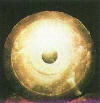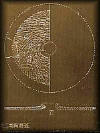In 1938 high in the
mountains of BayanKara-Ula, on the borders of China and
Tibet
a team of archaeologists were conducting a very detailed routine
survey of a series of interlocking caves. Their interests had been
excited by the discovery of lines of neatly arranged graves which
contained the skeletons of what must have been a race of human
beings. They appeared to have spindly bodies and large overdeveloped
heads.
At first it had been thought that the caves had been the home of a
hitherto unknown species of ape. But as the species seemed to
bury its dead they eliminated an ape race. While studying the
skeletons one of the members of the team stumbled on a large round
stone disc half buried in the dust on the floor of the cave.
The disc looked like an Stone Age record. There was a hole in
the center of and a fine spiral groove that is a continuous
spiraling line of closely written characters. No one understood the
meanings of the message. The disc was labeled and filed away among
other finds in the area. For 20 years many experts in Peking tried
to translate the disc. Finally Dr. Tsum Um Nui broke the code
and started to decipher the "speaking grooves". The Peking
Academy of Pre-History
forbade him to publish his findings.
In 1965, 716 more grooved stone discs were uncovered in the same
caves. They told the story of a "space probe" by the
inhabitants of another planet who came to the Baya-Kara-Ula mountain
range. They had crash landed. Their peaceful intentions had been
misinterpreted. Many of them had been hunted down and killed by
members of the Han tribe, who lived in the neighboring caves.
They referred to themselves as the Dropas. They said they came
down from the clouds in their space craft. It crashed landed in
remote and inaccessible mountains. There was no way to build a new
ship. Legend in the area spoke of small gaunt yellow faced men who
came from the clouds long ago. The men had huge bulging heads and
puny bodies. They were so ugly they were hunted down and killed.
This description is similar to the bodies found in the caves. On the
walls of the caves archaeologists found crude pictures of the
rising Sun, the Moon, unidentifiable stars and the earth all
joined together by lines of pea-sized dots. The cave drawings have
been dated around 12,000 years ago.
The cave area is still inhabited by 2 semi-troglodyte tribes
known as the Hans and the Dropas. These tribes are odd
looking in appearance. They are frail and stunted in growth
averaging only about 5 feet in height. They are neither typically
Chinese nor Tibetan. In Russia several of the rock were tested. The
discs were found to contain large amounts of cobalt and other
metallic substances. When placed on a special turntable they
vibrated or hummed in an unusual rhythm as thought an electric
charge was passing through them. It is as if they formed some part
of an electrical circuit.
ANOTHER STORY ABOUT THE DROPA STONES
Chi Pu Tei, a professor of archaeology at Beijing University,
was leading some his students on an expedition to survey a series of
interlinking caves in the Himalayan mountains. According to one
account, the caves may have been artificially carved, and were more
like a complex system of tunnels and underground storerooms. The
walls were squared and glazed, as if cut into the mountain with a
source of extreme heat. Inside the caves were several ancient, but
neatly arranged burial sites, and in them the skeletal remains of a
strange people. The skeletons, measuring a little more than four
feet tall, were frail and spindly with disproportionately large
skulls.
At first. it was suggested by a member of the team that these might be
the remains of an unknown species of mountain gorilla. Professor
Chi Pu Tei is reputed to have responded, "Who ever heard of
apes burying one another?" Yet, what kind of human was this?
More discoveries made further in the caves all but ruled out the
idea that these were apes. On the walls were carved pictograms of
the heavens: the sun, the moon, the stars, and the Earth with lines
of dots connecting them. Then the team made the most incredible
discovery of all. Half-buried in the dirt floor of the cave was an
odd stone disk, obviously fashioned by the hand of an intelligent
creature.
The disk was approximately nine inches in diameter and three-quarters
of an inch thick. In the exact center was a perfectly round, 3/4"
hole, and etched in its face was a fine groove spiraling out
from the center to the rim, making the disk look for all the world
like some kind of primitive phonograph record.
This one plate, dated to be between 10,000 and 12,000 years old --
older by far than the great pyramids of Egypt -- was fantastic
enough, but the wonder was multiplied manyfold. In all, 716 such
plates were found. And each held an incredible secret. The groove,
upon further inspection, was not a groove at all, but a continuous
line of strange carved hieroglyphics -- writing!
The tiny, almost microscopic characters were in a language never
encountered before. It wasn't until 1962 that another Chinese
scientist was able to decode the message of the stone plates.
The Message of the Dropas
Dr. Tsum Um Nui felt the smooth face of the disk with the palm
of his hand. "What could this disk possibly be?" he wondered.
He knew of its recent history; how it was discovered in 1938 by a
Chinese archaeologist in a cave high in the Himalayans, along with
715 similar disks; how buried nearby were skeletons of a strange
tribe of people averaging only a little over four feet high; how it
was found that each disk was inscribed with a tiny groove that
spiraled around its face, and that the groove turned out to be an
unknown hieroglyphic.
He also knew how the disks, as remarkable as they were, had been
simply labeled along with other finds of the expedition and stored
away at Beijing University for 20 years. During that time, others
had attempted to decipher the strange inscriptions, but without
success. Perhaps now, in 1962, he could. The professor painstakingly
transcribed the characters from the disk to paper.
The writing was so small he had to use a magnifying glass to see it
clearly. But the stones were old -- perhaps 12,000 years old, it was
estimated -- and much of the hieroglyphics were difficult to make
out or had been worn away by time and the elements. As he worked,
many questions nagged the professor. How did these primitive people
fashion these precise stones? How did they manage the almost
microscopic writing? Who were they and what was the purpose of these
hundreds of stones? Once the characters were transcribed, Dr.
Tsum Um Nui began the arduous task of trying to decode its
message. Eventually, he began to make progress.
A word emerged. Then another. A phrase became understandable, then an
entire sentence. He had broken the code. He discerned that the
messages on the stones were written by a people who called
themselves the Dropa. But what they were saying to him 12,000
years later made no sense. What the Dropa had written must have been
one of their cultural myths, or was part of some prehistoric
religious ceremony. Or was it?. When he had completed the
translation as much as he could, the professor sat back in his chair
in disbelief. The story the Dropa related was nothing short of
astounding. How would his colleagues react? How might the world
react if this story was true? The professor wrote up a paper on his
findings and presented it to the university for publication.
Their reaction was swift and emphatic: the paper would not be
published. The Academy of Prehistory expressly forbade him to
publish or even speak of his findings. The world, the academy
decided, should not know about the Dropa and their fateful journey
to Earth.
Dr. Tsum Um Nui's findings were eventually published, however.
Just two years later, he published the paper entitled, "The
Grooved Script Concerning Spaceships Which, as Recorded on the
Discs, Landed on Earth 12,000 Years Ago". By some accounts, the
academy relented and gave permission to the professor to publish the
paper, and by other accounts he published it despite the official
ban.
In either case, his translation and his theory were met with ridicule
by the archaeology establishment. The translation was just too
shattering to be taken at face value or as an historical account. It
just could not be true. It would change everything we know about our
history and humankind's place in the universe.
What the Stones Reveal
The Dropa disks tell the story of a space probe from a distant planet
that crash-landed in the Baian-Kara-Ula mountains of the
Himalayas. The occupants of the spacecraft - the Dropa - found
refuge in the caves of the mountains. Despite their peaceful
intentions, the Dropa were misunderstood by members of the Ham tribe
who were occupying neighboring caves and who hunted down the aliens
and even killed some of them.
A translation of one of the passages says:
"The Dropa came down
from the clouds in their aircraft. Our men, women, and children hid
in the caves ten times before sunrise. When at last they understood
the sign language of the Dropa, they realized that the newcomers had
peaceful intentions".
The stones go on to say how the Dropa were unable to repair their
disabled spacecraft and could not return to their home planet, and
so were stranded on Earth. If that's true, have their descendents
survived?.
Today, the isolated area is inhabited by two tribes of people who, in
fact, call themselves the Dropa and the Han.
Anthropologists have been unable to categorize either tribe into any
other known race; they are neither Chinese nor Tibetan. Both tribes
are of pygmy stature, adults measuring between 3-foot-6 and 4-foot-7
with an average height of 4-foot-2, and body weights of 38 to 52
pounds. They are yellow-skinned with thin bodies and
disproportionately large heads, corresponding to the skeletal
remains found in the caves in 1938.
They have sparse hair on their bodies and have large eyes that are not
Asian in aspect, but have pale blue irises. Supposedly, there also
is an ancient Chinese tale that might bear-out the Dropa's claims.
The tale relates the story of a small, slender, yellow-skinned
people who descended to the Earth from the clouds, and who were
shunned by everyone because of their ugliness.
Strange Properties
In 1968, the Dropa stones came to the attention of W. Saitsew,
a Russian scientist who re-published the findings of Tsum Um Nui and
conducted tests on the disks that revealed some very peculiar
properties. Physically, the granite stones contained high
concentrations of cobalt and other metals -- a very hard
stone indeed that would have made it difficult for the primitive
people to carve the lettering, especially with such minute
characters. When testing a disk with an
oscillograph, a surprising oscillation rhythm was recorded as if,
the scientists said, they had once been electrically charged or had
functioned as electrical conductors.
Whatever their true nature, origin, or meaning, the Dropa stones
present an intriguing puzzle for archaeologists and anthropologists.
Were the Dropa truly visitors from some distant planet, or is their
story merely a creation myth imagined by a primitive culture? If the
latter is true, it adds one more such "myth" to the large number of
stories from ancient cultures that claim their descendents came to
Earth from the heavens. And if the former is true, the Dropa stones
could represent the first recorded visit of an alien civilization to
our planet. For now, the Dropa stones remain unexplained.
|



